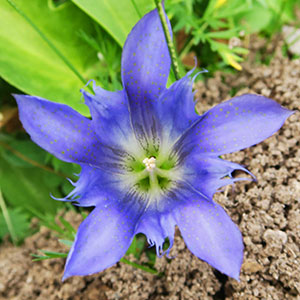Gentiana puberulenta
Gentiana newberryi
downy gentian, prairie gentian
alpine gentian, Newberry's gentian
1–5(–20), terminal from caudex, erect or nearly so.
1–5, arising laterally below rosettes, from a stout tap root, tufted, decumbent.
cauline, ± evenly spaced;
blade narrowly oblong-lanceolate, 1.5–7 cm × 4–18 mm, apex obtuse to acute.
basal and cauline;
blades of basal rosette and proximal cauline leaf blades widely spatulate to obovate or oblanceolate, 0.8–5 cm × 2–25 mm, apex obtuse or mucronate, at least these leaves with blades less than 6 times as long as wide, distal cauline leaves few, with blades oblanceolate to lanceolate or linear, 2–5 cm × 2–5 mm, apices acute.
1–6-flowered dense cymes or heads, sometimes with additional flowers at 1–3 nodes or on short branches.
terminal, flowers usually solitary, occasionally 2 or 3.
calyx 11–36 mm, lobes linear, 4–18(–25) mm, margins ciliate;
corolla deep blue or rarely rose-violet, narrowly campanulate, open, (30–)35–60 mm, lobes spreading or ± recurved, ovate, 6–15 mm, free portions of plicae divided less than 1/2 their length into 2 ± triangular, lacerate segments;
anthers distinct.
calyx 14–30 mm, lobes linear to narrowly ovate, (4–)6–12 mm, margins not ciliate;
corolla white or blue, campanulate, open, 23–55 mm, lobes spreading, elliptic-obovate, 7–17 mm, free portions of plicae divided into 2 triangular, serrate to lacerate segments;
anthers distinct.
winged.
winged.
= 26.
Gentiana puberulenta
Gentiana newberryi
Gentiana puberulenta is evidently extirpated from Ontario, Louisiana, Maryland, and New York, where outlying prairie communities have largely been eliminated by agricultural and urban expansion.
The name Gentiana puberula Michaux 1803, not Franchet 1890, and the homotypic synonym Dasystephana puberula (Michaux) Small have long and often been misapplied to this species but are typified by a specimen of G. saponaria.
Some small plants of Gentiana puberulenta appear similar to G. affinis var. affinis, but only a few specimens appear actually to be hybrids between these species. Where their ranges approach each other, the flowers of G. affinis are generally much smaller than those of G. puberulenta, and the corolla lobes of G. affinis are generally less than twice as long as the free portions of the plicae, whereas those of G. puberulenta are more than twice as long. The flower size of G. affinis var. ovata more closely approaches that of G. puberulenta, but in that variety, the range of which does not overlap that of G. puberulenta, the leaves are usually ovate to elliptic rather than narrowly oblong-lanceolate, and the distal internodes are often about as long as or longer than the leaves, in contrast to the proportionately shorter internodes of G. puberulenta. For further guidance in distinguishing between G. puberulenta and G. affinis, see discussion under 13. G. affinis.
Hybrids of Gentiana puberulenta with the strikingly dissimilar G. andrewsii, constituting G. × billingtonii Farwell (as species), and with G. flavida, constituting G. × curtisii J. S. Pringle, occur in the tall-grass prairies. Hybrids with G. saponaria formerly occurred in western Maryland.
(Discussion copyrighted by Flora of North America; reprinted with permission.)
Varieties 2 (2 in the flora).
The two varieties of Gentiana newberryi intergrade extensively. The most distinctive form of var. newberryi, with relatively tall stems and medium to deep blue corollas, occurs in the northern part of the range of the species, from the Klamath and White mountains of California north into Oregon. Plants most clearly referable to var. tiogana prevail in the southern part of the range of the species, from Butte County south to Inyo and Tulare counties, California. In the central part of the range of the species, plant size and corolla color are less consistently correlated, with occasional plants combining low stature with deep blue corollas or tall stems with predominantly white or pale blue corollas. In that part of the range, corolla color may be highly variable within a single population.
The leaves of Gentiana newberryi are thick-textured and distinctively concave, usually spoon-shaped, when fresh. Narrower leaves sometimes occur in var. tiogana, but many plants of that variety have widely spatulate leaves like those of var. newberryi.
(Discussion copyrighted by Flora of North America; reprinted with permission.)
1. Corollas medium to deep blue with greenish to dark purple lines abaxially on and below lobes, usually 35–55 mm. | var. newberryi |
1. Corollas white to pale blue except for greenish to dark purple lines abaxially on and below lobes, usually 23–42 mm. | var. tiogana |


